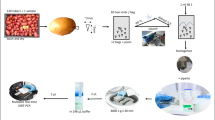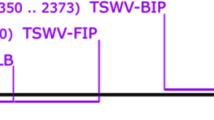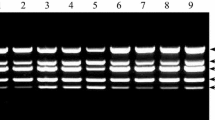Abstract
Four pospiviroid detection methods consisting of a pair of RT-PCR (ANSES 1-2), a pair of real time RT-PCR (Botermans 1-2) and two single RT-PCR methods (Luigi and Olivier) were evaluated for their relative accuracy, diagnostic sensitivity, diagnostic specificity, analytical sensitivity and reproducibility through a comparison in eight laboratories. All detection methods were tested on 13 tomato leaf and nine tomato seed samples as well as on 100-fold dilutions of the corresponding RNA extracts. Two different RNA extraction kits and three combinations of RNA extraction and RT-PCR kits were assessed. According to the statistical analysis of the results, ANSES 1-2 method provided the best performance criteria whatever the matrix consisted of, while the relative accuracies of Botermans 1-2 and Olivier methods were not significantly different from ANSES 1-2 for seed and leaf samples respectively. The results also showed that the relative accuracy of the Luigi and Olivier methods significantly increased when primer concentrations were raised to 1 μM, the latter method giving the best relative accuracy of the test in these conditions. No statistical differences were observed between accuracies obtained for the two extraction kits or the three combinations of extraction and RT-PCR kits used. ANSES 1-2 method is proposed as international standard for the generic detection of pospiviroids on tomato leaves and seeds.
Similar content being viewed by others
References
ANSES. (2013). Détection des Pospiviroïdes sur feuilles de plantes hôtes par RT-PCR en point final. MOA 034 version 1a.
Antignus, Y., Lachman, O., & Pearlsman, M. (2007). Spread of Tomato apical stunt viroid (TASVd) in greenhouse tomato crops is associated with seed transmission and bumble bee activity. Plant Disease, 91, 47–50.
Bates, D., Maechler, M., Bolker, B. & Walker, S. (2013). lme4: Linear mixed-effects models using Eigen and S4. R package version 1.0-4. http://CRAN.R-project.org/package=lme4.
Bolker, B. M., Brooks, M. E., Clark, C. J., Geange, S. W., Poulsen, J. R., Stevens, M. H., & White, J. S. (2009). Generalized linear mixed models: a practical guide for ecology and evolution. Trends in Ecology & Evolution, 24, 127–135.
Botermans, M., van de Vossenberg, B. T. L. H., Verhoeven, J. T. J., Roenhorst, J. W., Hooftman, M., Dekter, R., & Meekes, E. T. M. (2013). Development and validation of a real-time RT-PCR assay for generic detection of pospiviroids. Journal of Virological Methods, 187, 43–50.
Candresse, T., Marais, A., Tassus, X., Suhard, P., Renaudin, I., Leguay, A., Poliakoff, F., & Blancard, D. (2010). First report of Tomato chlorotic dwarf viroid in tomato in France. Plant Disease, 94, 633.
EPPO. (2010). PM 7/76 (2): use of EPPO diagnostic protocols. EPPO Bulletin, 40, 350–352.
EPPO. (2014). PM 7/98 (2): specific requirements for laboratories preparing accreditation for a plant pest diagnostic activity. EPPO Bulletin, 44, 117–147.
Efsa, PLH Panel (EFSA Panel on Plant Health). (2011). Scientific opinion on the assessment of the risk of solanaceous pospiviroids for the EU territory and the identification and evaluation of risk management options. EFSA Journal, 9, 2330.
Fleiss, J. L., Levin, B., & Paik, M. C. (2003). Statistical methods for rates and proportions (3rd ed.). New York: Wiley.
Jaeger, T. F. (2008). Categorical data analysis: away from ANOVAs (transformation or not) and towards logit mixed models. Journal of Memory and Language, 59, 434–446.
Gamer, M., Lemon, J., Singh, P. & Fellows, I. (2012). irr: various coefficients of interrater reliability and agreement. Retrieved from http://CRAN.R-project.org/package=irr.
Hothorn, T., Bretz, F., & Westfall, P. (2008). Simultaneous inference in general parametric models. Biometrical Journal, 50, 346–363.
Kryczyński, S., Paduch-Cichal, E., & Skrzeczkowski, L. J. (1988). Transmission of three viroids through seed and pollen of tomato plants. Journal of Phytopathology, 121, 51–57.
Luigi, M., Costantini, E., Luison, D., Mangiaracina, P., Tomassoli, L., & Faggioli, F. (2014). A diagnostic method for the simultaneous detection and identification of pospiviroids. Journal of Plant Patholology, 96, 151–158.
Monger, W., Tomlinson, J., Boonham, N., Marn, M. V., Plesko, I. M., Molinero-Demilly, V., Tassus, X., Meekes, E., Toonen, M., Papayiannis, L., Perez-Egusquiza, Z., Mehle, N., Jansen, C., & Nielsen, S. L. (2010). Development and inter-laboratory evaluation of real-time PCR assays for the detection of pospiviroids. Journal of Virological Methods, 169, 207–210.
Olivier, T., Demonty, E., Fauche, F., & Steyer, S. (2014). Generic detection and identification of pospiviroids. Archives of Virology, 159, 2097–2102.
R Core Team. (2013). R: A language and environment for statistical computing. R Foundation for Statistical Computing, Vienna, Austria. ISBN 3-900051-07-0, URL http://www.R-project.org/.
Singh, R. P., & Dilworth, A. D. (2009). Tomato chlorotic dwarf viroid in the ornamental plant Vinca minor and its transmission through tomato seed. European Journal of Plant Pathology, 123, 111–116.
Spieker, R. L. (1996). A viroid from Brunfelsia undulate closely related to the Columnea latent viroid. Archives of Virology, 141, 1823–1832.
Tiberini, A., & Barba, M. (2012). Optimization and improvement of oligonucleotide microarray-based detection of tomato viruses and pospiviroids. Journal of Virological Methods, 185, 43–51.
Torchetti, E. M., Navarro, B., & Di Serio, F. (2012). A single polyprobe for detecting simultaneously eight pospiviroids infecting ornamentals and vegetables. Journal of Virological Methods, 186, 141–146.
Verhoeven, J. T. J., Jansen, C. C. C., Willemen, T. M., Kox, L. F. F., Owens, R. A., & Roenhorst, J. W. (2004). Natural infections of tomato by Citrus exocortis viroid, Columnea latent viroid, Potato spindle tuber viroid and Tomato chlorotic dwarf viroid. European Journal of Plant Pathology, 110, 823–831.
Warton, D. I., & Hui, F. K. C. (2011). The arcsine is asinine: the analysis of proportions in ecology. Ecology, 92, 3–10.
Zhang, Y. J., Yin, J., Jiang, D. M., Xin, Y. Y., Ding, F., Deng, Z. N., Wang, G. P., Ma, X. F., Li, F., Li, G. F., Li, M. F., Li, S. F., & Zhu, S. F. (2013). A Universal oligonucleotide microarray with a minimal number of probes for the detection and identification of viroids at the genus level. PLoS ONE, 8(5), e64474.
Acknowledgments
We would like to thank all the people without whom this work would not have been possible: Alex Deterville, Michel Facq, Daniel Goderniaux, Davide Luison, Barbara Grubar and Tanja Kokalj for their indispensable help in the labs and in the greenhouses. This work would not have been possible without the financial support of: the Walloon Agricultural Research Center, the Belgian Agency for the Safety of the Food Chain, the Italian Ministry of Agriculture (grant No. D.M. 27241/7303/11), the Ministry of Agriculture of Lithuania, the Estonian Ministry of Agriculture (grant No. 3.4-23/574 19.03.2014), the Slovenian Research Agency (grant No. P4-0072), the FP7 Project CropSustaIn (grant agreement FP7-REGPOT-CT2012-316205) and the Austrian Agency for Health and Food Safety. This study was part of the pilot project DEP2 (Detection and Epidemiology of Pospiviroids 2) which was initiated in the framework of Euphresco 2 (FP7 European research project).
Author information
Authors and Affiliations
Corresponding author
Rights and permissions
About this article
Cite this article
Olivier, T., Šveikauskas, V., Demonty, E. et al. Inter-laboratory comparison of four RT-PCR based methods for the generic detection of pospiviroids in tomato leaves and seeds. Eur J Plant Pathol 144, 645–654 (2016). https://doi.org/10.1007/s10658-015-0803-8
Accepted:
Published:
Issue Date:
DOI: https://doi.org/10.1007/s10658-015-0803-8




